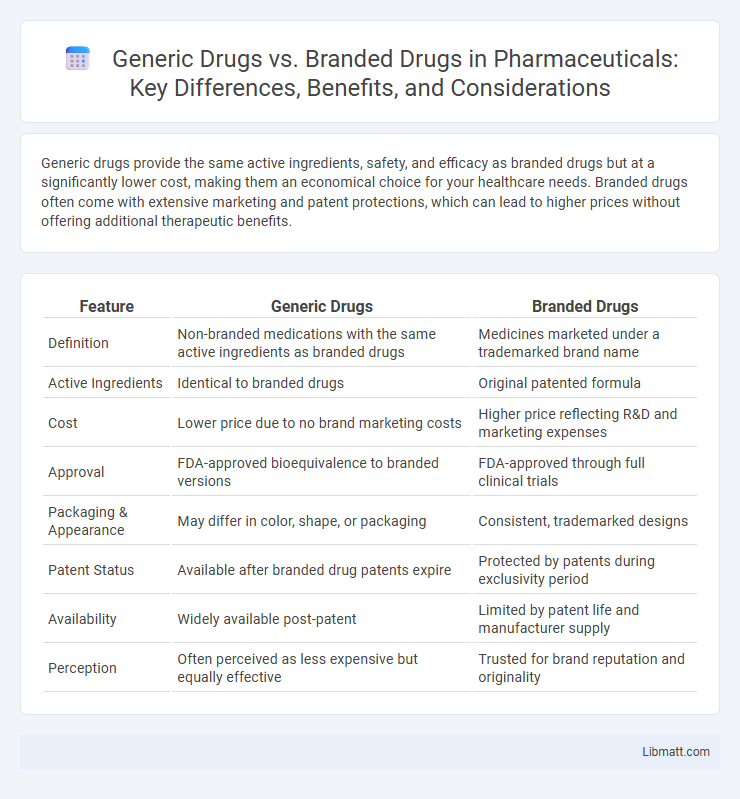Generic drugs provide the same active ingredients, safety, and efficacy as branded drugs but at a significantly lower cost, making them an economical choice for your healthcare needs. Branded drugs often come with extensive marketing and patent protections, which can lead to higher prices without offering additional therapeutic benefits.
Table of Comparison
| Feature | Generic Drugs | Branded Drugs |
|---|---|---|
| Definition | Non-branded medications with the same active ingredients as branded drugs | Medicines marketed under a trademarked brand name |
| Active Ingredients | Identical to branded drugs | Original patented formula |
| Cost | Lower price due to no brand marketing costs | Higher price reflecting R&D and marketing expenses |
| Approval | FDA-approved bioequivalence to branded versions | FDA-approved through full clinical trials |
| Packaging & Appearance | May differ in color, shape, or packaging | Consistent, trademarked designs |
| Patent Status | Available after branded drug patents expire | Protected by patents during exclusivity period |
| Availability | Widely available post-patent | Limited by patent life and manufacturer supply |
| Perception | Often perceived as less expensive but equally effective | Trusted for brand reputation and originality |
Introduction to Generic and Branded Drugs
Generic drugs contain the same active ingredients, dosage, safety, and efficacy as branded drugs but are typically sold at lower prices due to reduced development costs. Branded drugs are patented medications marketed under a proprietary name, often associated with extensive research and marketing expenses. Understanding the differences helps you make informed choices about cost-effective treatment options without compromising quality.
Defining Generic Drugs
Generic drugs are pharmaceutical medications equivalent to branded drugs in dosage, strength, route of administration, quality, and intended use but are sold under their chemical names rather than brand names. They contain the same active ingredients as branded drugs and must meet stringent regulatory standards for bioequivalence established by agencies like the FDA. Lower-cost options, generic drugs become available after the expiration of branded drug patents, offering affordable alternatives without compromising safety or efficacy.
What Are Branded Drugs?
Branded drugs are pharmaceutical products marketed under a proprietary, trademark-protected name given by the original manufacturer. They undergo extensive clinical trials, regulatory approval, and carry a higher price due to research, marketing, and brand recognition. You may encounter branded drugs when prescriptions specify a particular product known for its established efficacy and quality assurance.
Key Similarities Between Generic and Branded Drugs
Generic and branded drugs contain the same active ingredients and are required to meet identical standards for safety, efficacy, and quality set by regulatory agencies like the FDA. Both types of drugs undergo rigorous testing to ensure they deliver the same therapeutic effects and dosage strength, providing reliable treatment for your medical conditions. They also share similar labeling and manufacturing practices, ensuring consistency in patient care and medication management.
Major Differences: Generic vs Branded Drugs
Generic drugs contain the same active ingredients, dosage forms, and therapeutic effects as branded drugs but are typically sold at lower prices due to the absence of brand-name marketing costs. Branded drugs often undergo extensive clinical trials and patent protection, resulting in higher prices and exclusive market rights during patent validity. While efficacy and safety are equivalent, variations may occur in inactive ingredients, pill appearance, and manufacturer reputation between generic and branded medications.
Regulatory Standards and Approval Processes
Generic drugs undergo stringent regulatory standards that require demonstrating bioequivalence to branded drugs, ensuring they deliver the same therapeutic effect and safety profile. Regulatory agencies such as the FDA or EMA mandate rigorous approval processes involving quality control, manufacturing practices, and clinical testing confirmation before granting market authorization. Understanding these protocols helps you trust that generic drugs meet the same efficacy and safety benchmarks as their branded counterparts.
Cost Comparison: Savings with Generics
Generic drugs offer significant cost savings compared to branded drugs, often priced 30% to 80% lower while maintaining the same active ingredients and therapeutic effects. These lower prices result from reduced development and marketing expenses, making generics an affordable option for patients managing long-term treatments. Choosing generic medications can greatly reduce your out-of-pocket expenses without compromising quality or efficacy.
Effectiveness and Safety Concerns
Generic drugs contain the same active ingredients as branded drugs and are rigorously tested to meet the same effectiveness and safety standards set by the FDA. You can trust that generics provide equivalent therapeutic benefits without compromising quality, though inactive ingredients may vary. Safety concerns are minimal when generics are purchased from reputable sources, ensuring comparable efficacy to branded medications.
Public Perception and Common Myths
Public perception often favors branded drugs due to their established reputation and marketing, despite generic drugs being equally effective and FDA-approved for safety and efficacy. Common myths suggest that generics are inferior or less safe, but these medications contain the same active ingredients and meet stringent regulatory standards. Studies consistently demonstrate that generic drugs provide the same therapeutic benefits at a significantly lower cost, challenging misconceptions about quality or performance.
Future Trends in Generic and Branded Pharmaceuticals
The future of generic and branded pharmaceuticals is shaped by increasing emphasis on biosimilars, advanced drug delivery systems, and personalized medicine, driving competitive pricing and innovation. Regulatory frameworks are evolving to streamline approval processes for generics while ensuring safety and efficacy, expanding market access globally. Integration of digital technologies and AI in drug development enhances predictive analytics, optimizing supply chains and patient-specific treatments in both sectors.
Generic drugs vs Branded drugs Infographic

 libmatt.com
libmatt.com